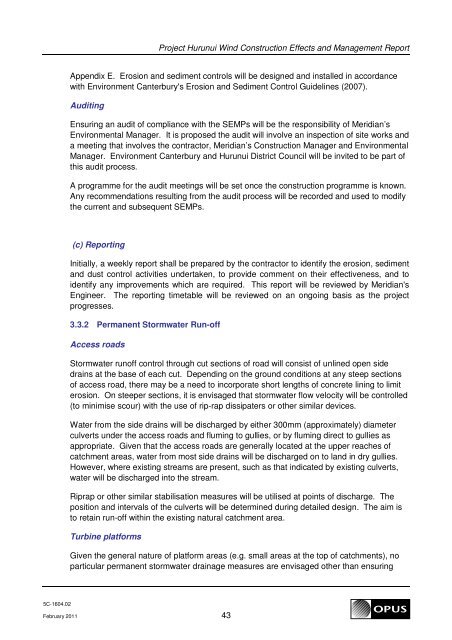Project Hurunui Wind Construction and Project Overview
Project Hurunui Wind Construction and Project Overview
Project Hurunui Wind Construction and Project Overview
You also want an ePaper? Increase the reach of your titles
YUMPU automatically turns print PDFs into web optimized ePapers that Google loves.
<strong>Project</strong> <strong>Hurunui</strong> <strong>Wind</strong> <strong>Construction</strong> Effects <strong>and</strong> Management Report<br />
Appendix E. Erosion <strong>and</strong> sediment controls will be designed <strong>and</strong> installed in accordance<br />
with Environment Canterbury's Erosion <strong>and</strong> Sediment Control Guidelines (2007).<br />
Auditing<br />
Ensuring an audit of compliance with the SEMPs will be the responsibility of Meridian’s<br />
Environmental Manager. It is proposed the audit will involve an inspection of site works <strong>and</strong><br />
a meeting that involves the contractor, Meridian’s <strong>Construction</strong> Manager <strong>and</strong> Environmental<br />
Manager. Environment Canterbury <strong>and</strong> <strong>Hurunui</strong> District Council will be invited to be part of<br />
this audit process.<br />
A programme for the audit meetings will be set once the construction programme is known.<br />
Any recommendations resulting from the audit process will be recorded <strong>and</strong> used to modify<br />
the current <strong>and</strong> subsequent SEMPs.<br />
(c) Reporting<br />
Initially, a weekly report shall be prepared by the contractor to identify the erosion, sediment<br />
<strong>and</strong> dust control activities undertaken, to provide comment on their effectiveness, <strong>and</strong> to<br />
identify any improvements which are required. This report will be reviewed by Meridian's<br />
Engineer. The reporting timetable will be reviewed on an ongoing basis as the project<br />
progresses.<br />
3.3.2 Permanent Stormwater Run-off<br />
Access roads<br />
Stormwater runoff control through cut sections of road will consist of unlined open side<br />
drains at the base of each cut. Depending on the ground conditions at any steep sections<br />
of access road, there may be a need to incorporate short lengths of concrete lining to limit<br />
erosion. On steeper sections, it is envisaged that stormwater flow velocity will be controlled<br />
(to minimise scour) with the use of rip-rap dissipaters or other similar devices.<br />
Water from the side drains will be discharged by either 300mm (approximately) diameter<br />
culverts under the access roads <strong>and</strong> fluming to gullies, or by fluming direct to gullies as<br />
appropriate. Given that the access roads are generally located at the upper reaches of<br />
catchment areas, water from most side drains will be discharged on to l<strong>and</strong> in dry gullies.<br />
However, where existing streams are present, such as that indicated by existing culverts,<br />
water will be discharged into the stream.<br />
Riprap or other similar stabilisation measures will be utilised at points of discharge. The<br />
position <strong>and</strong> intervals of the culverts will be determined during detailed design. The aim is<br />
to retain run-off within the existing natural catchment area.<br />
Turbine platforms<br />
Given the general nature of platform areas (e.g. small areas at the top of catchments), no<br />
particular permanent stormwater drainage measures are envisaged other than ensuring<br />
5C-1604.02<br />
February 2011 43
















